Co-Remediation of Acid Mine Drainage and Industrial Effluent Using Passive Permeable Reactive Barrier Pre-Treatment and Active Co-Bioremediation
Abstract
:1. Introduction
2. Methodology
2.1. Acid Mine Drainage and Industrial Effluent Collection and Storage
2.2. Process Design and Description
2.3. Equipment and Materials
2.3.1. Pervious Concrete Materials and Construction
2.3.2. Seed Sludge Collection, Storage and Loading
2.4. Bioreactor Operational Protocol
2.5. Chemical Analysis
3. Results and Discussions
3.1. Acid Mine Drainage Pre-Treatment
3.2. Biological Co-Remediation
4. Discussions
5. Conclusions
Author Contributions
Funding
Data Availability Statement
Acknowledgments
Conflicts of Interest
References
- Byrne, P.; Wood, P.J.; Reid, I. The Impairment of River Systems by Metal Mine Contamination: A Review Including Remediation Options. Crit. Rev. Environ. Sci. Technol. 2012, 42, 2017–2077. [Google Scholar]
- Park, I.; Tabelin, C.B.; Jeon, S.; Li, X.; Seno, K.; Ito, M.; Hiroyoshi, N. A review of recent strategies for acid mine drainage prevention and mine tailings recycling. Chemosphere 2019, 219, 588–606. [Google Scholar] [PubMed]
- Taylor, J.; Pape, S.; Murphy, N. A Summary of Passive and Active Treatment Technologies for Acid and Metalliferous Drainage (AMD); Earth Systems: Frementle, Australia, 2005. [Google Scholar]
- Thisani, S.; Kallon, D.; Byrne, P. Geochemical Classification of Global Mine Water Drainage. Sustainability 2020, 12, 10244. [Google Scholar]
- Gunes, B.; Stokes, J.; Davis, P.; Connolly, C.; Lawler, J. Pre-treatments to enhance biogas yield and quality from anaerobic digestion of whiskey distillery and brewery wastes: A review. Renew. Sustain. Energy Rev. 2019, 113, 109281. [Google Scholar]
- Opollo, S.O. Integrated Anaerobic Digestion and UV Photocatalytic Treatment of Industrial Wastewater in Fluidized Bed Reactors. Ph.D. Thesis, Vaal University of Technology, Vanderbjilpark, South Africa, 2016. [Google Scholar]
- Ahmad, T.; Aadil, R.M.; Ahmed, H.; Rahman, U.U.; Soares, B.C.; DE Souza, S.L.Q.; Pimentel, T.C.; Scudino, H.; Guimarães, J.T.; Esmerino, E.A.; et al. Treatment and utilization of dairy industrial waste: A review. Trends Food Sci. Technol. 2019, 88, 361–372. [Google Scholar]
- Li, J.; Luo, G.; He, L.; Xu, J.; Lyu, J. Analytical Approaches for Determining Chemical Oxygen Demand in Water Bodies: A Review. Crit. Rev. Anal. Chem. 2018, 48, 47–65. [Google Scholar]
- Papirio, S.; Villa-Gomez, D.K.; Esposito, G.; Pirozzi, F.; Lens, P.N. Acid Mine Drainage Treatment in Fluidized Bed Bioreactors by Sulfate Reducing Bacteria: A Critical Review. Critical Rev. Environ. Sci. Technol. 2013, 43, 2545–2580. [Google Scholar]
- Thisani, S.K.; Kallon, D.V.V.; Byrne, P. A fixed bed pervious concrete anaerobic bioreactor for biological sulphate remediation of acid mine drainage using simple organic matter. Sustainability 2021, 13, 6529. [Google Scholar]
- Akinpelu, E.A.; Ntwampe, S.K.O.; Fosso-Kankeu, E.; Waanders, F. Comparative analysis of brewing wastewater and lactate as carbon sources for microbial community treating acid mine drainage in anaerobic MBBR systems. Environ. Technol. 2020, 42, 3955–3962. [Google Scholar]
- Moodley, I.; Sheridan, C.M.; Kappelmeyer, U.; Akcil, A. Environmentally sustainable acid mine drainage remediation: Research developments with a focus on waste/by-products. Miner. Eng. 2018, 126, 207–220. [Google Scholar]
- Novhe, O.; Yibas, B.; Coetzee, H.; Atanasova, M.; Netshitungulwana, R.; Modiba, M.; Mashalane, T. Long-Term Remediation of Acid Mine Drainage from Abandoned Coal Mine Using Integrated (Anaerobic and Aerobic) Passive Treatment System, in South Africa: A Pilot Study. In Proceedings of the International Mine Water Association Conference, Freiberg, Germany, 11–15 July 2016; pp. 668–674. [Google Scholar]
- Rose, P. Review: Long-term sustainability in the management of acid mine drainage wastewaters—Development of the Rhodes BioSURE Process. Water SA 2013, 39, 582. [Google Scholar]
- Sun, R.; Li, Y.; Lin, N.; Ou, C.; Wang, W.; Zhang, L.; Jiang, F. Removal of heavy metals using a novel sulfidogenic AMD treatment system with sulfur reduction: Configuration, performance, critical parameters and economic analysis. Environ. Int. 2020, 136, 105457. [Google Scholar]
- Neda, A.; Whittington-Jones, K.; Rose, P.D. Salinity, Sanitation and Sustainability Vol. 4: The Rhodes BioSURE Process; Water Research Commission: Pretoria, South Africa, 2007; Volume 4. [Google Scholar]
- Pionapen, J.; Wentzel, M.C.; Ekama, G.A. Biological sulphate reduction with primary sewage sludge in an upflow anaerobic sludge bed (UASB) reactor—Part 1: Feasibility study. Water SA 2009, 35, 525–534. [Google Scholar]
- Thisani, S.; Kallon, D.; Byrne, P. Review of Remediation Solutions for Acid Mine Drainage Using the Modified Hill Framework. Sustainability 2021, 13, 8118. [Google Scholar]
- Kaksonen, A.H.; Sahinhaya, E. Review of sulfate reduction based bioprocesses for acid mine drainage treatment and metals recovery. Eng. Life Sci. 2007, 7, 541–564. [Google Scholar]
- Opollo, S.; Aoyi, O. Combined anaerobic digestion and photocatalytic treatment of distillery effluent in fluidized bed reactors focusing on energy conservation. Environ. Technol. 2016, 37, 2243–2251. [Google Scholar]
- Sánchez, E.; Borja, R.; Travieso, L.; Martín, A.; Colmenarejo, M.F. Effect of organic loading rate on the stability, operational parameters and performance of a secondary upflow anaerobic sludge bed reactor treating piggery waste. Bioresour. Technol. 2005, 3, 335–344. [Google Scholar]
- Rosanti, D.; Wibowo, Y.G.; Safri, M.; Maryani, A.T.; Ramadhan, R.S. Bioremediations Technologies on Wastewater Treatment: Opportunities, Challenges and Economic Perspective. Sainmatika J. Ilm. Mat. Ilmu Pengetah. Alam 2020, 17, 142–156. [Google Scholar]
- Thisani, S.K.; Von Kallon, D.V.; Byrne, P. Effects of Contact Time and Flow Configuration on the Acid Mine Drainage Remediation Capabilities of Pervious Concrete. Sustainability 2021, 13, 10847. [Google Scholar]
- Suponik, T. Ensuring permeable reactive barrier efficacy and longevity. Arch. Environ. Prot. 2010, 36, 59–73. [Google Scholar]
- Shabalala, A.N.; Ekolu, S.O.; Diop, S.; Solomon, F. Pervious concrete reactive barrier for removal of heavy metals from acid mine drainage-column study. J. Hazard. Mater. 2017, 323, 641–653. [Google Scholar] [PubMed]
- Majersky, G. Metals Recovery from Acid Mine Drainage Using Pervious Concrete; VDM Publishing: Saarbrucken, Germany, 2009; p. 69. [Google Scholar]
- Solpuker, U.; Sheets, J.; Kim, Y.; Schwartz, F.W. Leaching potential of pervious concrete and immobilization of Cu, Pb and Zn using pervious concrete. J. Contam. Hydrol. 2014, 161, 35–48. [Google Scholar] [PubMed]
- Olds, W.E.; Tsang, D.C.W.; Weber, P.A.; Weisener, C.G. Nickel and Zinc Removal from Acid Mine Drainage: Roles of Sludge Surface Area and Neutralising Agents. J. Min. 2013, 2013, 698031. [Google Scholar]
- Rico, C.; Montes, J.A.; Rico, J.L. Evaluation of different types of anaerobic seed sludge for the high rate anaerobic digestion of pig slurry in UASB reactors. Bioresour. Technol. 2017, 238, 147–156. [Google Scholar]
- Gilbert, O.; de Pablo, J.; Cortina, J.L.; Ayora, C. Chemical characterization of natural organic substrates for biological mitigation of acid mine drainage. Water Res. 2004, 38, 4186–4196. [Google Scholar]
- Zhou, S.; Wang, J.; Peng, S.; Chen, T.; Yue, Z. Anaerobic co-digestion of landfill leachate and acid mine drainage using up-flow anaerobic sludge blanket reactor. Environ. Sci. Pollut. Res. 2021, 28, 8498–8506. [Google Scholar]

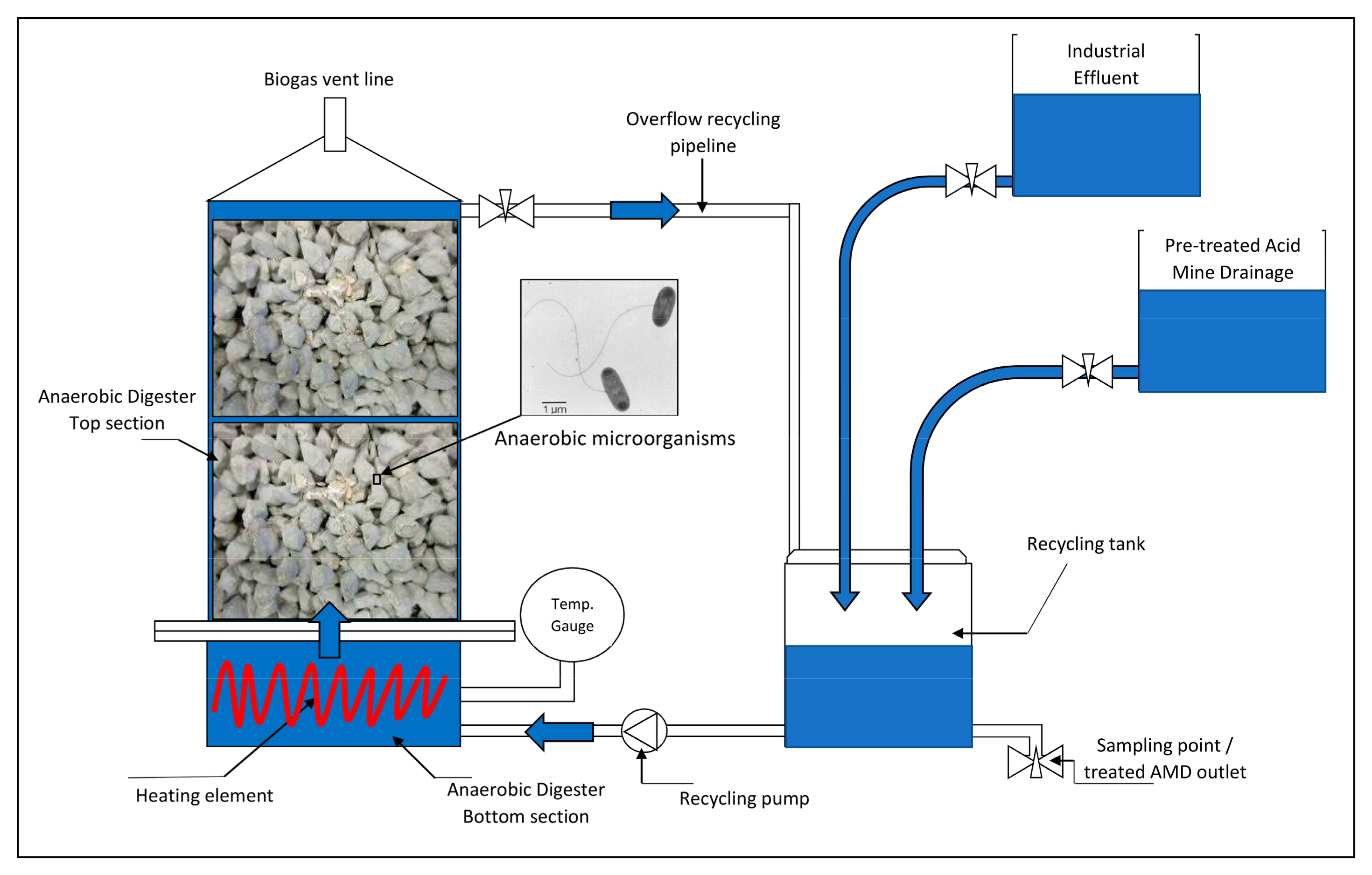
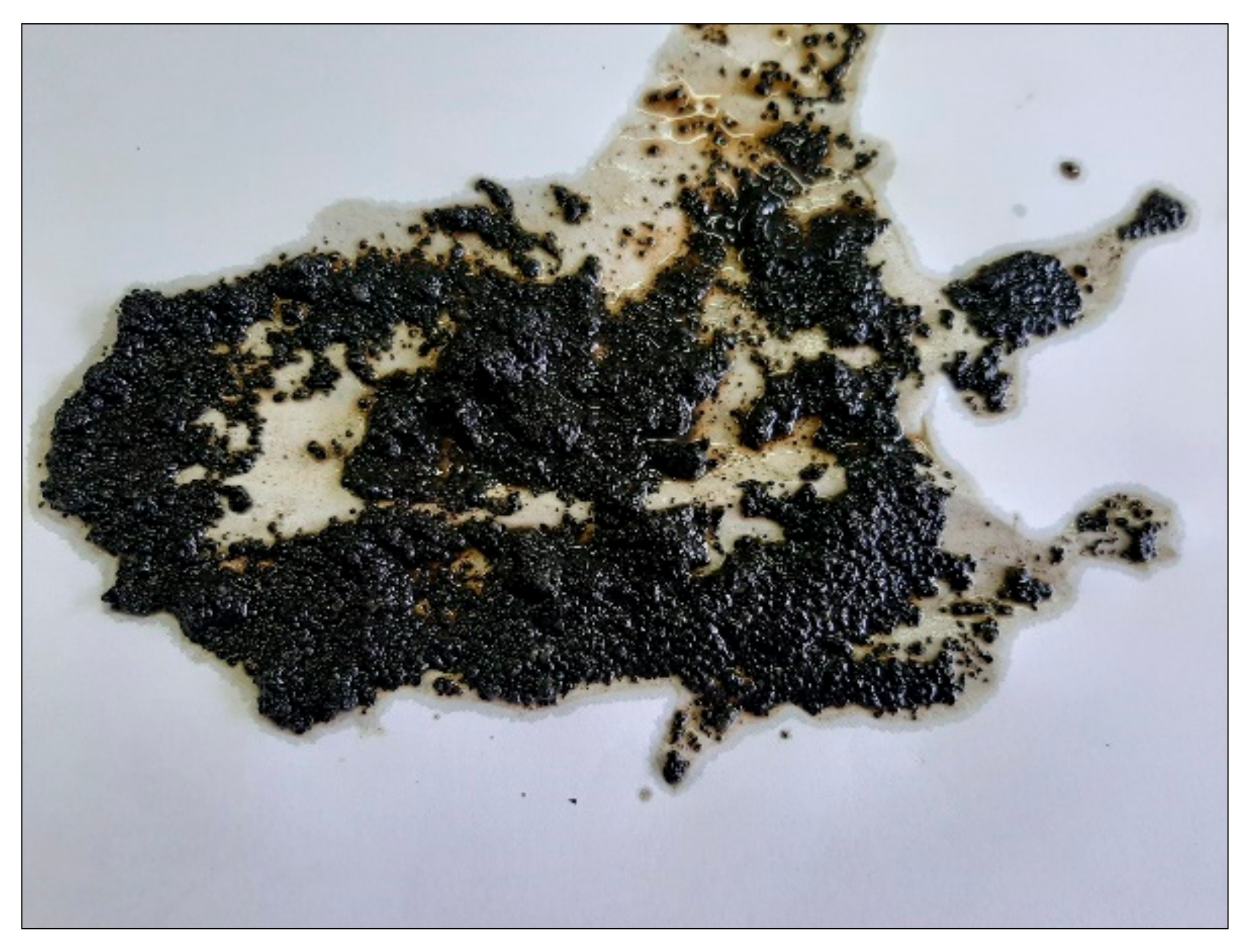
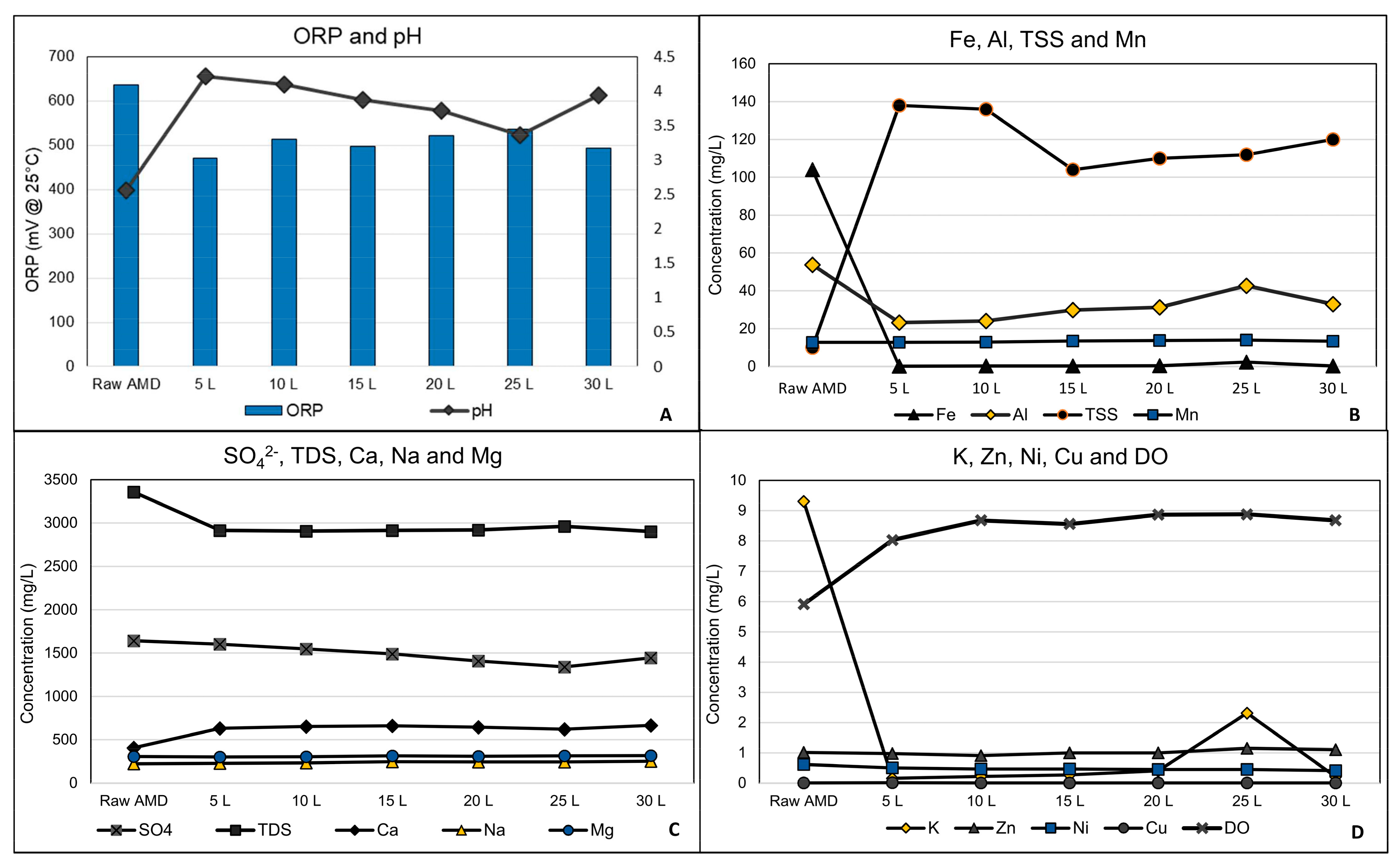

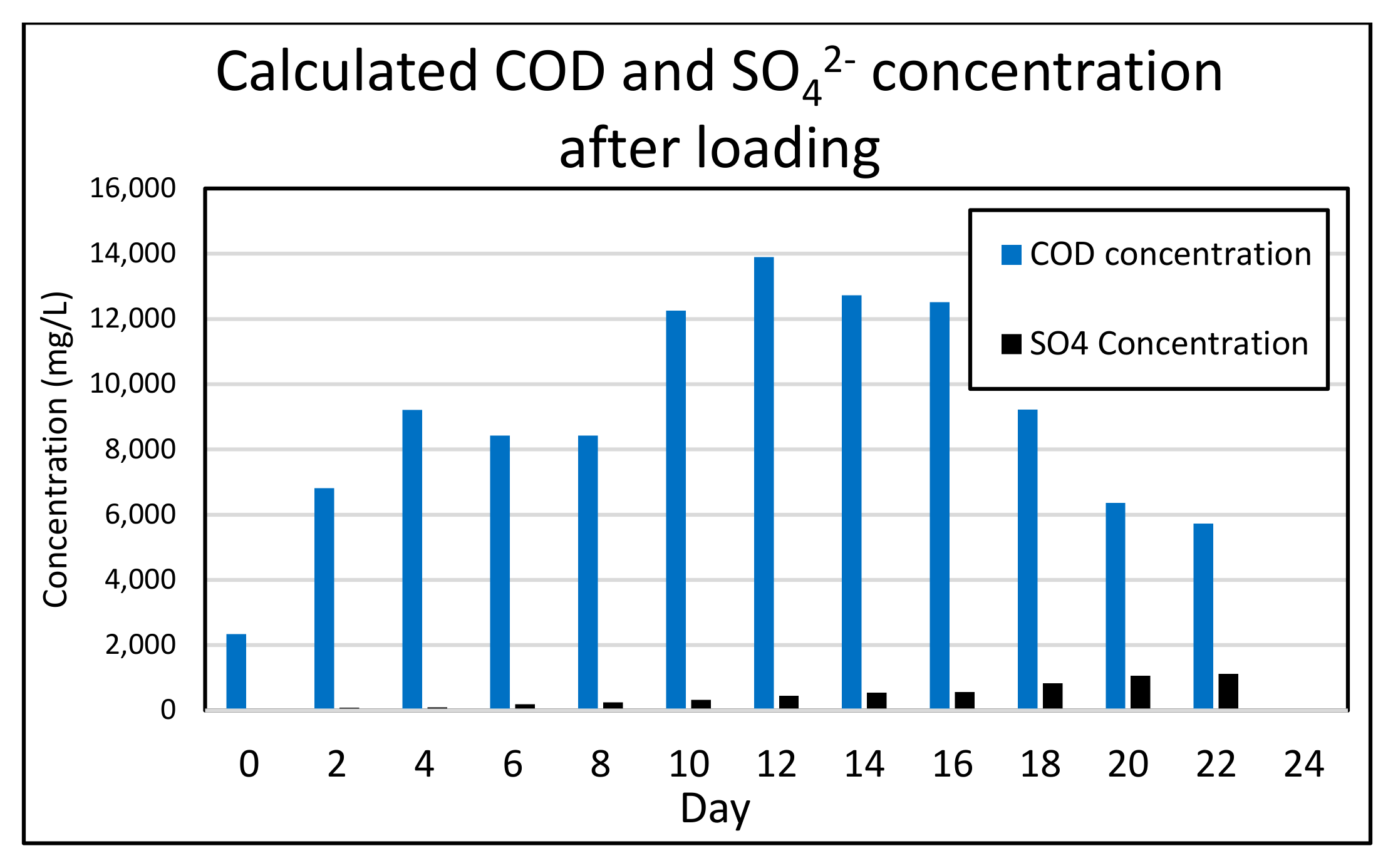
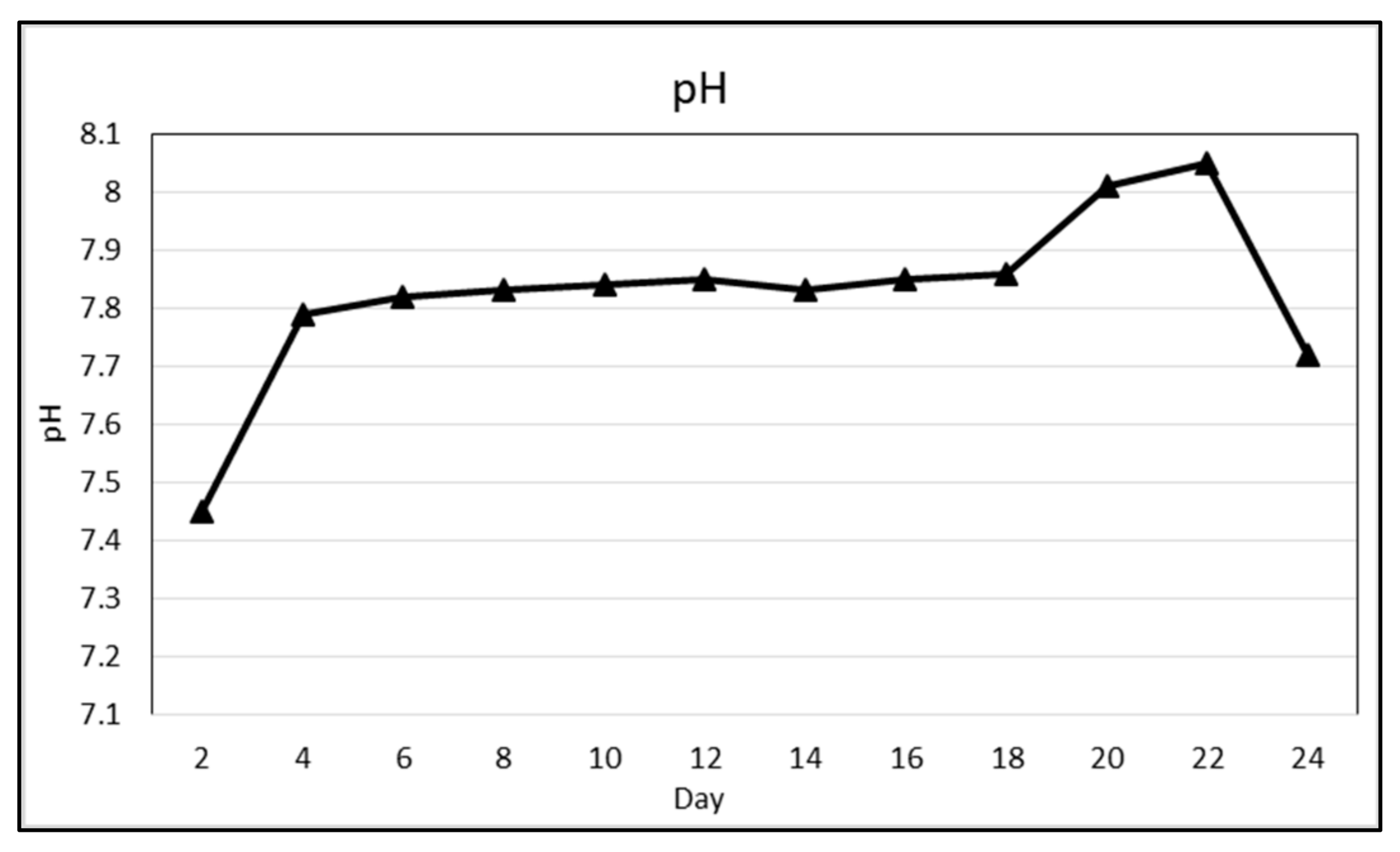

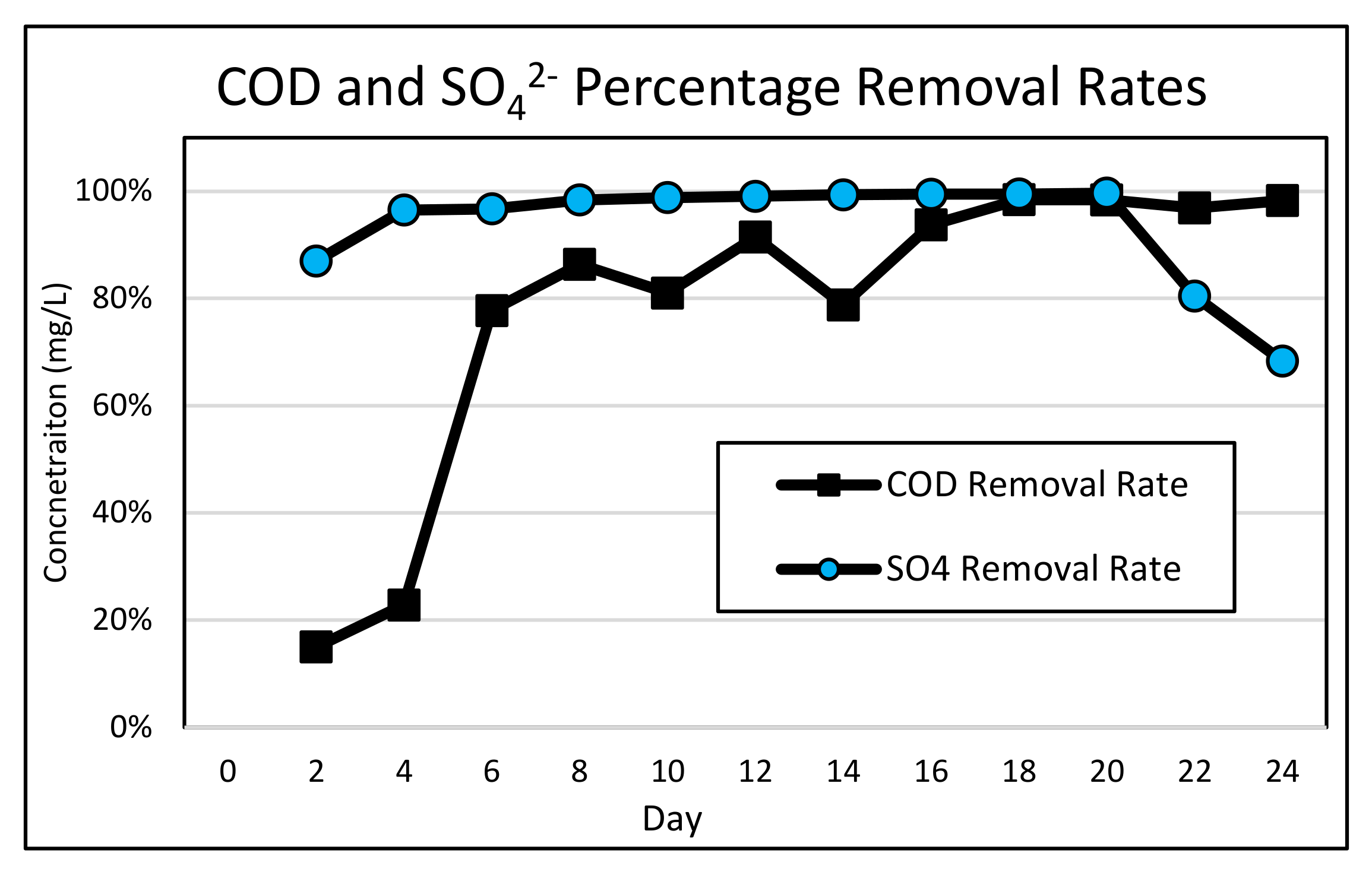


| DO (mg/L) | ORP (mV) | pH | SO4 (mg/L) | TDS (mg/L) | TSS (mg/L) | Al (mg/L) | Ca (mg/L) | Cu (µm/L) | Fe (mg/L) | K (mg/L) | Mg (mg/L) | Mn (mg/L) | Na (mg/L) | Ni (mg/L) | Zn (mg/L) |
|---|---|---|---|---|---|---|---|---|---|---|---|---|---|---|---|
| 5.91 | 636.6 | 2.56 | 1642 | 3357 | 10 | 53.8 | 408 | 13.1 | 104 | 9.31 | 306 | 12.8 | 224 | 0.62 | 1.02 |
| pH | Chemical Oxygen Demand (mg/L) | Total Organic Carbon (mg/L) |
|---|---|---|
| 3.43 | 19,500 | 5543 |
| Cube Description | Mix Proportion (Dry)-kg per m3 | % Extender | Porosity | ||||||
|---|---|---|---|---|---|---|---|---|---|
| CEM 1 | Fly Ash | Silica Fume | 9.5 mm Granite | 13.2 mm Granite | Optima 175 | Water | |||
| Pre-treatment | 197 | 18 | 9 | 1462 | - | 1.75 | 75 | 12.1% | 21.5% |
| Fixed Bed AD | 152 | 14 | 7 | - | 1468 | 1.35 | 60 | 12.1% | 33.2% |
| Ramp-up Cycle No | Experimental Duration (h) | AMD Loading Volume (L) | SO42− Loading Rate (kg SO42−/m3/Day) | COD Loading Volume (L) | COD Loading Rate (kg COD/m3/Day) | COD to SO42− Ratio |
|---|---|---|---|---|---|---|
| 0 | 0 | 0.054 | 0.02 | 0.72 | 2.64 | 164.56 |
| 24 | ||||||
| 1 | 48 | 0.1 | 0.03 | 0.70 | 2.57 | 86.39 |
| 72 | ||||||
| 2 | 96 | 0.12 | 0.04 | 1.04 | 3.08 | 86.39 |
| 120 | ||||||
| 3 | 144 | 0.22 | 0.07 | 0.84 | 3.30 | 50.49 |
| 168 | ||||||
| 4 | 192 | 0.3 | 0.09 | 0.84 | 3.30 | 37.03 |
| 216 | ||||||
| 5 | 240 | 0.4 | 0.12 | 1.26 | 4.62 | 38.88 |
| 264 | ||||||
| 6 | 288 | 0.64 | 0.19 | 1.60 | 5.87 | 30.85 |
| 312 | ||||||
| 7 | 336 | 0.9 | 0.27 | 1.7 | 6.23 | 23.31 |
| 360 | ||||||
| 8 | 384 | 1 | 0.30 | 1.8 | 6.60 | 22.22 |
| 408 | ||||||
| 9 | 432 | 2 | 0.59 | 1.8 | 6.60 | 11.11 |
| 456 | ||||||
| 10 | 480 | 2475 | 0.74 | 1.2 | 4.40 | 5.98 |
| 504 | ||||||
| 11 | 528 | 3 | 0.89 | 1.25 | 4.58 | 5.14 |
| 552 | ||||||
| 576 |
| Raw AMD | Raw Confectionery Effluent | Treated Wastewater Quality | DWA Discharge Standards | SANS 241:2015 Potable Quality | Units | |
|---|---|---|---|---|---|---|
| pH | 2.56 | 3.43 | 7.45–8.05 | 5.5–9.5 | 5.5–9.5 | |
| COD | - | 19,500 | 1493 | 400 | mg/L | |
| SO42− | 1642 | 49.25 | 250 | mg/L | ||
| Fe | 104 | 0.94 | 0.3 | 0.3 | mg/L | |
| Al | 53.80 | 0.46 | 0.03 | 0.3 | mg/L | |
| Zn | 1.02 | 0.15 | 0.1 | 5 | mg/L | |
| Cu | 0.01 | 0.01 | 0.01 | 2 | mg/L | |
| Ni | 0.662 | 0.171 | 0.07 | mg/L | ||
| Mn | 12.8 | 0.716 | 0.1 | mg/L |
Publisher’s Note: MDPI stays neutral with regard to jurisdictional claims in published maps and institutional affiliations. |
© 2022 by the authors. Licensee MDPI, Basel, Switzerland. This article is an open access article distributed under the terms and conditions of the Creative Commons Attribution (CC BY) license (https://creativecommons.org/licenses/by/4.0/).
Share and Cite
Thisani, S.K.; Kallon, D.V.V.; Byrne, P. Co-Remediation of Acid Mine Drainage and Industrial Effluent Using Passive Permeable Reactive Barrier Pre-Treatment and Active Co-Bioremediation. Minerals 2022, 12, 565. https://doi.org/10.3390/min12050565
Thisani SK, Kallon DVV, Byrne P. Co-Remediation of Acid Mine Drainage and Industrial Effluent Using Passive Permeable Reactive Barrier Pre-Treatment and Active Co-Bioremediation. Minerals. 2022; 12(5):565. https://doi.org/10.3390/min12050565
Chicago/Turabian StyleThisani, Sandisiwe Khanyisa, Daramy Vandi Von Kallon, and Patrick Byrne. 2022. "Co-Remediation of Acid Mine Drainage and Industrial Effluent Using Passive Permeable Reactive Barrier Pre-Treatment and Active Co-Bioremediation" Minerals 12, no. 5: 565. https://doi.org/10.3390/min12050565
APA StyleThisani, S. K., Kallon, D. V. V., & Byrne, P. (2022). Co-Remediation of Acid Mine Drainage and Industrial Effluent Using Passive Permeable Reactive Barrier Pre-Treatment and Active Co-Bioremediation. Minerals, 12(5), 565. https://doi.org/10.3390/min12050565







